Facebook Marketing in 2022: How to Use Facebook for Business
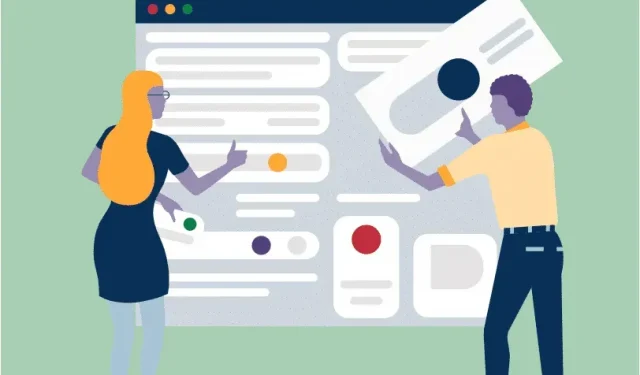
If you represent a brand hoping to succeed on social media, mastering Facebook marketing will be key.
More than 2.8 billion people use the platform every month . That’s a lot of potential eyeballs on your business.
Because here’s the thing about Facebook: while you might think it’s just a place where your aunt can leave cryptic comments on your vacation photos, it’s also a place where the audience can connect with businesses big and small.
In fact, two-thirds of Facebook users report visiting a local business’s Facebook page at least once a week. This digital marketplace is just bustling, if not too bold of us.
That’s right: people are looking for you! But if you want to engage this audience, you can’t just rely on luck. A targeted Facebook marketing strategy is essential. Keep an eye on the prize (and off your aunt’s comments).
Ready to master the art of Facebook marketing? Here’s everything you need to know for the coming year.
Step by step guide to setting up Facebook for business
If you’re on a budget, we have good news: Setting up a Facebook Page for your business is completely free.
Then, once you’ve created your Page, you can use it to create content, share contact information, link to your website, build a product catalog, and communicate with your customers… for free too.
If you have money to spare (show off!), it is possible to use paid marketing strategies such as Facebook ads and sponsored posts from your Facebook business page.
But the first step is to set up this Facebook page (did we mention it’s free?). Here’s how:
- Go to facebook.com/pages/create (Note: You need to be logged into your personal account to get started, but don’t worry, your personal information won’t appear on your new business page.)
- Select the page type: Business/Brand or Community/Public Figure.
- Enter your company details.
- Upload your profile and cover photos. Be sure to use the optimal image sizes for Facebook so that they look their best.
- Click “Edit Page Information”: here you can fill in your description, contact information, and any other relevant details such as hours of operation.
- Click “Create @Username Page”to create a custom URL. It can be up to 50 characters long and makes it easy for people to find you on Facebook.
- Click “Add Button”below your cover photo to customize a call to action such as “Shop”or “Contact Us.”
- Pat yourself on the back: you’ve just launched a Facebook business page to the world! And she is beautiful!
If you need further assistance with the installation process, we can help you. Check out our full post on how to create a Facebook page for business.
Facebook post types
Now that you have a Facebook business page that you can call your own… it’s time to create the content.
On Facebook, you can create different types of posts. Each has its own benefits and can elicit engagement in different ways. Your brand strategy and goals on social media will most likely influence the style of your posts.
Here we break down all the different options you have for posting on a Facebook Page, including examples to inspire you.
Facebook text post (also known as status post)
This is an OG Facebook post: just text.
We only speak words here. No photos. No video. No links.
They’re direct and to the point, but if your goal is to drive traffic to your website or directly convert leads into sales, text messaging isn’t the best option. The social media algorithm doesn’t like these naked posts too much either, and they usually don’t get much exposure in the news feed.
However, text posts are good for sparking a conversation. Use a text message to ask a question or call for feedback.
Text messages can also be useful for sharing important information your audience might be looking for on your Page, such as ticket availability or opening hours.
facebook photo post
Generally speaking, photo posts get a lot more engagement than text posts. An eye-catching photo (or illustration or infographic, we’re not picky!) is a great way to capture the attention of a potential customer as they browse your news feed.
For product-focused companies in particular, photos that show products in action can be really effective. Carbohydrate lovers, for example, might be put off by these photos of The Soap Dispensary bread baskets featuring delicious sourdough loaves. Breathtaking!
And don’t worry if you’re not a professional photographer or if you’re selling something that’s hard to capture in an image, stock photos can help you with that. (In fact, here are 25 free photo sites worth checking out! Just make sure you fully understand the basics of image copyright before you start posting.)
facebook video post
Video posts show even higher levels of engagement than photo posts. Whether it’s a short video ad or a long, expertly crafted narration video, a video can be incredibly compelling.
Vox publishes explainer videos right on their feed so that users can soak up all the information right on Facebook and easily comment, react or post to their feeds. This textbook on vaccines, for example, has 1,400 shares.
On Facebook, the video plays automatically in the news feed, so you’re almost guaranteed to grab the attention of users. This is the perfect trap!
For specific Facebook video marketing tips, check out our six key elements of the perfect social video.
Facebook Live Publishing
If you don’t like pre-recorded videos, try playing with Live.
Facebook Live video is a live stream directly on your Facebook Page. This medium is very, very popular – in the spring of 2020, the Facebook Live audience increased by 50%.
Live video is an intimate and authentic way to connect with your followers. These broadcasts can be used for Q&A, behind-the-scenes tours, product demos, and more.
The British Council ran a poll to answer questions about their English courses, garnering over 7,000 views and sparking active discussion in the comments of people who watched the live broadcast.
Ready to go live? We have a whole separate post on the marketing potential of Facebook Live right here!
Linked content post (also known as link posts)
A linked post is a post where the URL is available to your followers. Just paste the link into the composition box and the website preview will open automatically. (Is it technology or magic? We may never know.)
Wealthsimple, for example, shared this how-to story link on their website. The meta image and description are enticing and attention grabbing: we want to stop writing this story to click and read it right now!
You can share a link to your website, but you can also share content from other sources, such as an interesting article about your industry. Whatever the content, be sure to add a few words to the post before hitting Publish to give your readers some context or inference.
Oh, and one more thing to keep in mind: Posts with links get more engagement than plain text posts, but significantly less than photos or videos.
Facebook Stories
Just like Instagram stories, Facebook stories are vertical photos or short videos that disappear after 24 hours. Photos appear for five seconds, and videos can be up to 20 seconds long.
Facebook stories are placed at the top of the news feed, which means they are immune to the Facebook algorithm. Perhaps that is why over half a billion people view Facebook stories every day.
This 60 Second Docs story, for example, is here today and gone tomorrow… but in the meantime, it certainly gives us an intriguing look at their content.
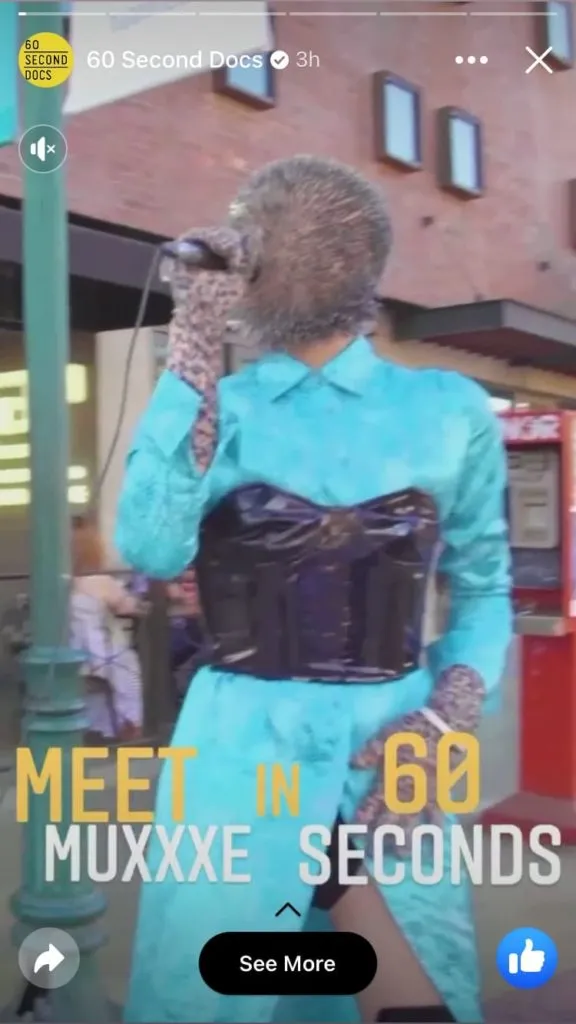
Attached Mail
A pinned post is any regular Facebook post that stays at the top of your Page. This ensures that it’s the first thing people see when they visit your Page.
Once you’ve created the post itself – whether it’s a text post, poll, or video – just click on the three dots in the right corner. You will have the option to “pin the post”. You can tell a post is pinned because it will say “Pinned Post”just above it, as in this Domestika example.
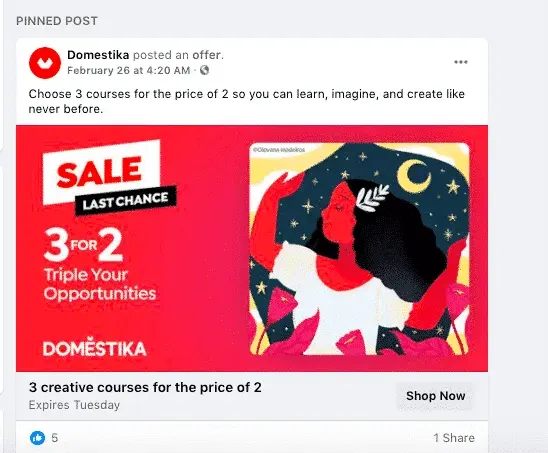
Use this feature to prevent important news or great content from getting lost in the shuffle. This is your chance to show potential followers why they should like your Page.
You can change your pinned post at any time.
Facebook Browsing Party
Watch Party is a way to show a public video on Facebook in real time so that you and your fans and followers can watch it together.
It’s a great way to draw attention to a new product launch or world premiere of a music video by turning a standard video into an event.
Red Table Talks does it – and if it’s good enough for Jaida Pinkett Smith, it should be good enough for you too!
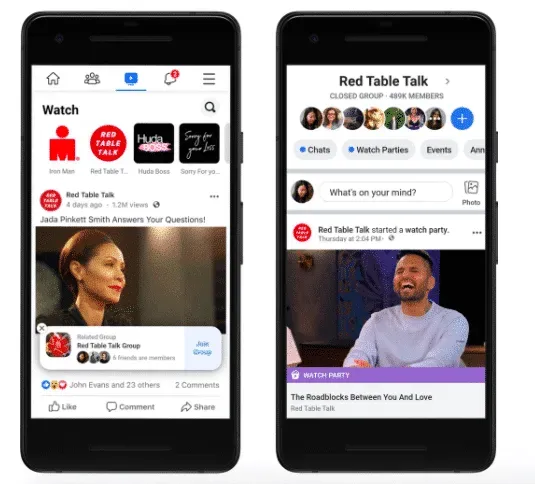
You can even promote Watch Party (or Facebook Live events) by creating an event.
Learn more about setting up a Watch Party on your Page here.
More hot options
You can also use Facebook Pages to post job listings and special offers if you want to recruit new employees or draw attention to a sale. There is also an opportunity to raise money for charity through a Facebook post.
Or you can just stare at your post options for hours, dumbfounded, paralyzed by choice…. totally up to you!
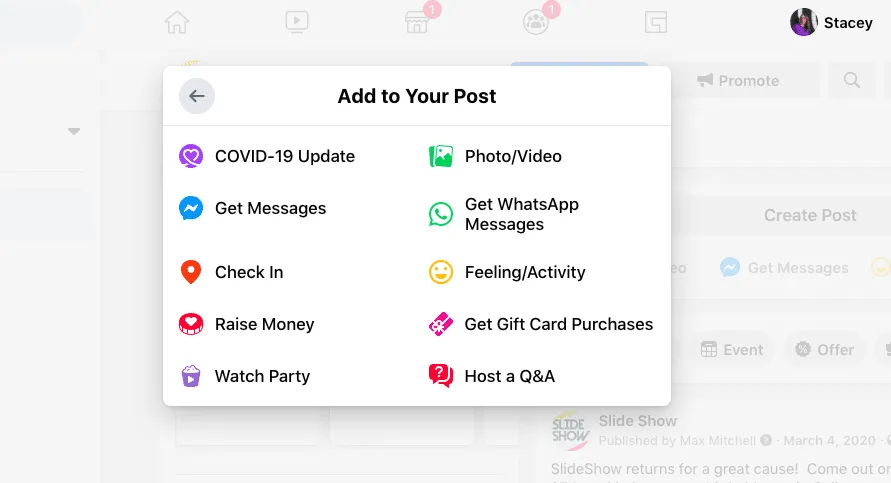
How to choose the perfect post type
Finding the perfect post type for your brand requires some experimentation. Try different combinations and follow the analytics to see what works.
You can also participate in social listening to find out what people like about your company…or what problems they would like you to solve. Also, keep an eye on what people are saying about your competitors. Yes, it’s an audition, but it’s for business purposes, so it’s okay. Just listen and learn.
The best place to start is by posting content that works well on other channels. Have you tweeted content that got a lot of response? Share it on Facebook too! Do you have a page on your blog that always gets new comments? This is another contender for a Facebook post.
That being said: For best results, be sure to share your content using best practices for cross-promotion, rather than just cross-posting.
How to Create a Facebook Marketing Strategy in 6 Easy Steps
So now you’re a Facebook posting expert. It was fast! Let’s look at some ideas to help you create a solid Facebook strategy to get the most out of your Page.
1. Define your audience
To effectively engage an audience, you must first understand who you are talking to. Find out who your target audience is by asking yourself the following questions:
- How old are your target followers?
- Where do they live?
- What are their jobs?
- What are their problems?
- How and when do they use Facebook?
Of course, it’s also important to understand the general demographics of Facebook users. Then, once you get an idea of who is actually using the platform and how it relates to your target customer, you can take a look at Facebook Audience Insights.
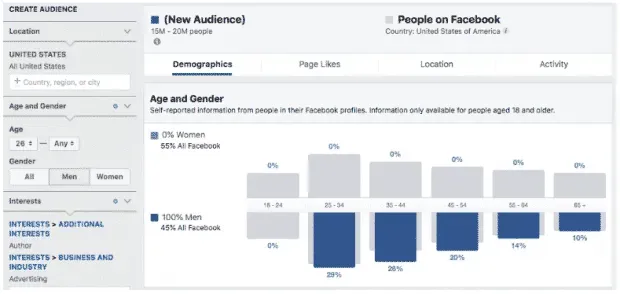
Facebook’s free built-in Audience Insights tool helps you get in-depth insights into your leads. You can use it to find information about things like:
- Age
- Floor
- Education
- Family status
- Location
- Language
- Using Facebook
- Past purchases
After all, if you have no idea who you are trying to contact, you are unlikely to ever reach them.
2. Set goals
What does your brand success look like? Sure, it can be tempting to view likes as the ultimate measure of accomplishment, but unless they’re part of a larger marketing plan, those likes mean nothing. Sometimes they are even called the vanity metric.
A clear goal related to your business goals is essential to creating an effective Facebook marketing strategy. Every business will have different goals, but everyone should focus on activities that affect their bottom line.
This may include:
- Lead Generation
- Increase conversions on your site
- Customer Service Improvement
Once you have decided what you want to achieve, we recommend charting specific, measurable ways to achieve that goal. We recommend using a recognized goal setting system, such as SMART goals or OKR goals. Check out our post on social media goal setting for more details and some inspiring examples.
Every post, every comment, every ad you create on Facebook should ultimately serve your purpose. To stay on track, it’s a good idea to create a Facebook mission statement for your brand, as well as a Facebook style guide to help ensure a consistent look, feel, and voice for all of your content.
(Sorry for giving you so much homework, but successful marketing sometimes requires a little sweat. Work!)
3. Plan your content mix
You have a target audience. You know your goals. Now it’s time to create those posts.
Finding the right mix of content takes trial and error, but a good rule of thumb is to use the 80-20 Rule: this means using 80% of your posts to inform, educate, and entertain, and the other 20% to promote. your brand.
That’s right: not every post needs to be about how good your company is. It gets old fast, like your girlfriend’s new boyfriend talking about bitcoin all through your birthday dinner.
Instead, aim to add value and build relationships with your followers. Give them content they enjoy regularly and they will be more open to your products and services when you tell them about them 20% of the time.
Another option to help you balance your content is the rule of thirds on social media. According to this school of thought, one third of your content should share ideas and stories, one third of your content should include personal interaction with your followers, and the rest of your content can promote your business.
Whatever specific number combination you choose, the goal is to balance promotional materials with value.
Hot tip: Facebook penalizes brands that push sales too hard. The algorithm, as it turned out, is not a fan of self-promotion. The platform wants to prioritize meaningful, engaging content, not just coupons.
Once you’ve decided what to post, your next step is to decide when to post it.
You can get some insight into engagement with Page Insights, but our research shows that the best times to post on Facebook are 6:15 am and 12:15 pm PST weekdays.
Whatever your schedule, remember that it’s important to post consistently.
Create a content calendar to help balance the mix of content types and organize frequency. This free content calendar template is one way to stay organized; The Hootsuite Scheduler is another great resource.
To learn more about strategic planning ideas, check out our article on how to create a social media marketing plan.
4. Optimize your page for engagement
Whatever your Facebook marketing goal is, it will be difficult to achieve if no one knows your Facebook page exists.
That’s why it’s important to a) get people to your page in the first place and b) get them to interact once they get there.
This video shares some great ways to fully optimize your Facebook business page for success:
Expert Tip: Add some love to your Facebook Page cover. It’s the first thing people see when they visit your Page, so make sure it looks good!
One easy way to help people find your business page on Facebook is cross-promotion. Help people who already interact with you on other platforms find you on Facebook by linking to your Page in your email signature and newsletter, and by using the Like and Share buttons on your website or blog.
To get those views, likes and follows are a little less scientific: you have to create content that can be shared. Posts that are valuable and interesting will (hopefully!) inspire followers to share them with their friends.
To increase engagement, it’s important to remember that you only get as much from Facebook as you put into it. You need to be involved too if you expect your followers to be engaged.
Responsiveness is a very valuable quality of brands, so be chatty. Reply to every post and comment, answer questions and update content. (In fact, you should schedule a regular audit of your Facebook page to check for and remove any outdated content. Your About Us section should always be accurate, up-to-date, and brand-appropriate.)
You can find more detailed strategies in our guide to getting more likes on Facebook and in this list of little-known Facebook tips and tricks.
5. Consider Using Other Facebook Tools
Once you get comfortable with running a Facebook business page, there are many more ways for brands to find interactions beyond posts and comments.
Facebook business manager
To take your Facebook Page to the next level, it’s also helpful to set up Facebook Business Manager. Facebook calls it “a one-stop shop for managing business tools, business assets, and employee access to those assets.”How can you resist?!
Simply put, Business Manager is a tool that allows you to manage your regular and paid Facebook posts. It also allows you to work effectively with team members and external contractors and agencies.
We’ll walk you through the setup process step by step in our guide to using Facebook Business Manager.
facebook groups
Groups are another great “extra credit” tool you can use to increase engagement. In a sense, Groups are the online equivalent of your favorite coffee shop or community center. These are digital spaces where people can share information and ideas… and hopefully passion for your brand. There are 1.4 billion people using Facebook groups every month, and that audience is too big to ignore.
You can also use Facebook Groups to showcase your expertise and provide added value to your fans, with bonus content or special offers that are for “members”only. This is a great way to build trust and enduring loyalty.
We have instructions for setting up your own Facebook group right here if you’re ready to add this tool to your Facebook business page toolkit.
But if people are passionate about your brand, you may not even need to create a dedicated space for them to gather: sometimes fans create their own Facebook group dedicated to your brand. If you find such groups around the world, it is recommended that you join so that you can follow the conversation and ensure that any misconceptions or negativity are nipped in the bud.
However, in general, fan-created Facebook groups are a great sign that you’re doing something right. Lucky you!
Facebook chatbot (also known as Facebook Messenger bot)
Facebook users exchange 20 billion messages with companies every month. Twenty billion! If you are unable to communicate with your customers through this platform, you may be missing out on the opportunity to connect with them.
However, it’s not just about setting up Facebook Messenger. It’s about being highly responsive to customer messages. Facebook research shows that users expect businesses to respond almost immediately. One Facebook user interviewed said he would only wait 10 minutes for a response before moving on to another brand.
Solution to these expectations? Chatbots: Automatic response tools that are always ready to help an interested customer, like this one from Booking.com.
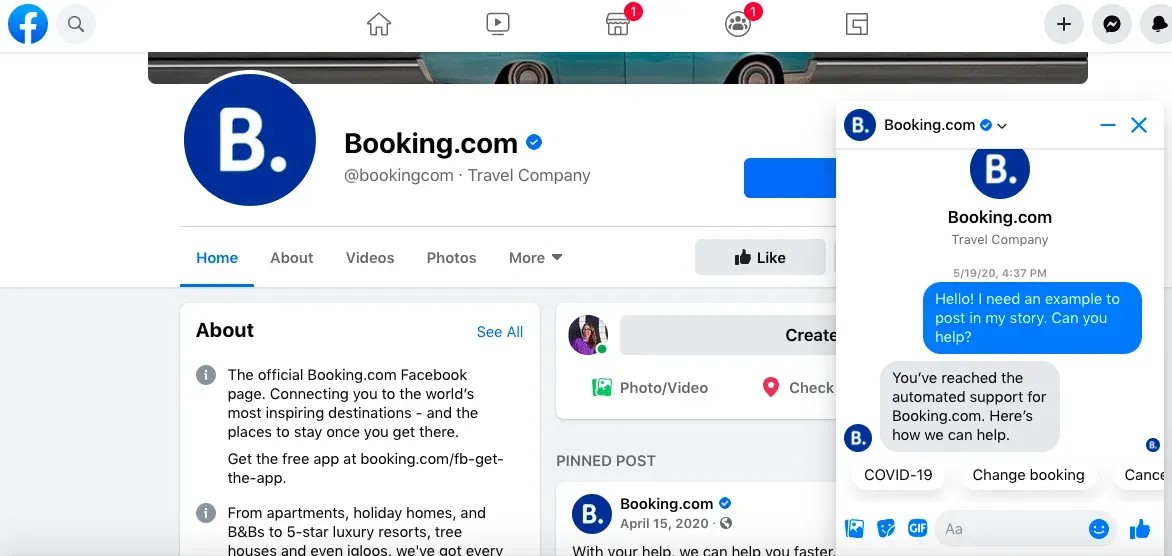
To set up your own Facebook chatbot, check out our step-by-step guide to creating a Facebook Messenger bot.
6. Enable Facebook Ads and Facebook Pixel
So you’ve created the perfect post: the wording is just right, the images are outstanding, and the question is very interesting. We hope that your subscribers will actually see it.
That’s right: not everything you post on your Facebook Page will reach your followers in their news feeds. You might be surprised by the percentage of followers your organic posts are most likely to reach:
- For pages with less than 10,000 followers: 8.18% organic reach.
- For pages with over 10,000 followers: 2.59% organic reach.
For better or worse, the Facebook algorithm prioritizes posts from users’ friends and family. This means that companies and brands sometimes just can’t stand out from the crowd.
Sometimes your great content just needs a little boost. Luckily, you can expand your reach without breaking the bank by using Facebook ads.
Like traditional advertising, Facebook ads are content that you pay for to share with a specific target audience. The goal is to get your brand in front of the right people, whether your goal is to increase brand awareness, engagement, or traffic.
For detailed instructions on how to run a targeted Facebook ad campaign, see our complete guide to Facebook advertising.
Even if you’re not ready to move on to Facebook advertising, it’s a good idea to set up your (free!) Facebook pixel right now.
The Facebook pixel is a simple piece of code that you place on your website to:
- track Facebook conversions
- remarketing to people who have already visited your site
- create a target user audience for future advertising
As soon as you place it on your site, the pixel will start collecting data. This way, whenever you’re ready to advertise, you’ll have powerful information for your retargeting campaigns at your fingertips.
How to measure the success of your strategy
Successful Facebook marketing requires maintenance: it’s not a “set it and forget it”situation.
Tracking and measurement is essential so you can understand what worked and what didn’t. This way you can learn, tweak and try again so your strategy keeps improving.
You can track audience engagement directly through Facebook Insights, which measures metrics like…
- like
- reach (how many people saw your posts)
- engagement (how many people liked, clicked, shared or commented on your content)
- which of your posts are causing people to dislike your Page
In addition, Facebook Insights helps you determine which post types work best for your Page, so you know if your current content set is working. Read more about this in our Facebook Analytics beginner’s guide.
Outside of Facebook, actions such as purchases or other website conversions need to be tracked using external tools such as Google Analytics, Hootsuite Impact, UTM Options, and Hootsuite Social Ads.
All this, as they say. .. do not get overwhelmed! We’ve created a detailed guide to guide you through the process of tracking the ROI of your Facebook marketing investment.
So get in there, get your hands dirty and learn as you go. More advanced strategies and campaigns will be available to you whenever you’re ready to level up… and our dozens and dozens of resources and guides will be ready to help you every step of the way.
Leave a Reply